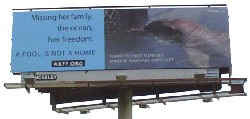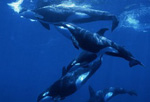 |
||
| Chlorinated
Cruelty: The Truth about Marine Parks and Aquariums |
||
|
From the Panhandle to the Florida Keys, the scene is familiar: crowds cheer as splashing orcas leap through the air for a handful of fish, dolphins are ridden by human performers as if they were water skis, and sea lions wave to the audience on command. Employees at marine parks like to tell audiences that the animals wouldn’t perform if they weren’t happy, and until now this assertion has gone largely unchallenged. But as news gets out about traumatic captures, barren concrete tanks, high mortality rates, and aberrant - even dangerous - animal behavior, people are beginning to realize that hidden behind the dolphin’s “smile” is an industry built on suffering. |
||
| Florida is the birthplace of, and still the biggest player in the marine park industry, with 13 attractions and 367 captive sea animals, more than any other state. |
 |
|
Families
Torn Apart The
capture of marine mammals is a violent procedure. Pods of orcas
and dolphins are chased to exhaustion using airplanes, boats,
harpoons, and explosives. Once cornered, pods are surrounded with
nets and capture teams search through the terrified groups for
the animals they want. Those selected are taken ashore and will
never see their ocean world or their pod again. Many die from
shock or injuries. Remaining family members often become frantic
upon seeing their captured companions and try to save them. When
Namu, an orca captured off the coast of Canada, was towed to the
Seattle Public Aquarium in a steel cage, her family followed for
miles. |
||
|
The United States still allows dolphins to be captured for marine parks - now banned in many countries. |
||
| Adapting
to an Alien World
 In
nature, orcas and dolphins enjoy the ability to move freely. Their
streamlined bodies and smooth skin enable them to gain fast speed,
and they are always on the move, swimming up to 100 miles a day.
They spend only 10-20 percent of their time on the water’s
surface and can hold their breath for as long as 30 minutes, diving
to depths of more than 1,640 feet. In
nature, orcas and dolphins enjoy the ability to move freely. Their
streamlined bodies and smooth skin enable them to gain fast speed,
and they are always on the move, swimming up to 100 miles a day.
They spend only 10-20 percent of their time on the water’s
surface and can hold their breath for as long as 30 minutes, diving
to depths of more than 1,640 feet. In captivity, orcas and dolphins are restricted by their tank or enclosure, which can measure a mere 24 feet by 24 feet wide and six feet deep. They can only swim a few feet before a wall or a fence stops them. Captive orcas and dolphins spend more than half of their time swimming in small circles or simply lying motionless on the surface of the water. Experts believe that this may account for the collapsed dorsal fins seen on the majority of captive orcas. Chlorine, copper and other harsh chemicals are used to disinfect animal wastes and keep the water clear. Animals suffer burning eyes, peeling skin and can even die from fluctuating or excessive chemicals. Former dolphin trainer Ric O’Barry, who trained dolphins for the television show Flipper, believes excessive chlorine has caused some dolphins to go blind. In order to force newly captured dolphins and orcas to perform inane circus tricks, trainers must first obtain complete control over them. This is accomplished by taking advantage of the captive dolphins’ powerless predicament: They depend totally on their keepers to be fed. Hungry animals quickly learn that only when they perform a desired behavior; such as waving at the audience or tail walking, do they get to eat. Isolating animals who refuse to perform is another common training method. Former dolphin trainer Doug Cartlidge maintains that highly social dolphins are punished by being isolated from other animals: “You put them in a pen and ignore them. It’s like psychological torture.” |
||
| A chlorinated tank, without ocean tides or other sea creatures is an abnormal environment for a dolphin. Their sonar bounces back at them from concrete walls. They have to swim in endless circles. Instead of chasing live prey all day, they eat dead fish dumped from a bucket. |
 |
|
|
Captivity’s
Tragic Consequences Captivity is a death sentence for orcas and dolphins and more than 3,850 marine mammals have died in captivity in the last 30 years. In the wild, dolphins can live to be 25 to 50 years old. Male orcas live between 50 and 60 years, females between 80 and 90 years. Orcas rarely survive more than 10 years in captivity. Common causes of death include, capture shock, pneumonia, chlorine poisoning, starvation, stress, drowning, and heat. To the marine park industry, these facts are accepted as routine operating expenses. |
||
| Miami Seaquarium has lost 64 of 89 dolphins since 1972. Of those whose age could be determined, more than half died at 10 or younger, including 16 in their first year. You pay the price of admission, the animals pay with their lives. |
 |
|
| A
Lesson in Mis-Education
The often-repeated justifications for marine parks as places of education and conservation have never stood up against examination. Traditional exhibits center on animals performing tricks that are exaggerated variations of their natural behaviors. These tricks prevent the audience from contemplating the barren concrete enclosures, so different from the environment from which these animals have been taken. Jacques Cousteau believed that captive dolphins are conditioned and deformed and bear little resemblance to dolphins living in freedom in the sea. It’s like studying human psychology only in prisons, which leads, obviously, to misinterpretations and absurd generalizations. Marine parks have shown no more interest in conserving marine mammals’ natural habitats than they have in educating audiences. In fact, the industry has actively lobbied to keep small cetaceans, such as orcas and dolphins, outside the jurisdiction of the International Whaling Commission (even though this would help to protect these animals in their natural habitat) because they don’t want to risk not being able to capture additional animals in the future. Marine parks destroy captive animals’ abilities to survive in the ocean and they vehemently oppose release efforts. |
||
|
Forcing animals to perform silly tricks for the public is nothing more than cheap circus. The only lesson imparted to the children is "You can make money by exploiting wildlife" |
||
|
Lack
of Regulation Federal agencies overseeing marine parks are responsible with enforcing Animal Welfare Act mandates on water quality levels, diet, medical care, and space requirements. However the government does little to enforce those minimum requirements and rarely levies fines or closes facilities. Repeated violators are allowed to continue operating for years even after documented contaminated water, starvation, or deaths. |
||
|
Inspectors "are generally overworked and there are not many of them," said David Cottingham, executive director of the U.S. Marine Mammal Commission. "There are very few who are trained in marine mammal veterinary sciences." |
||
|
Thanks,
But No Tanks! Fortunately, for marine mammals, more and more people are becoming concerned about marine mammal suffering, and uncomfortable at sea circuses. Citizens are now speaking out loudly that dolphins and whales belong in the ocean. |
||
 During
2006, ARFF targeted
the cruel display of whales and dolphins at Orlando marine parks
with a billboard on Florida's Turnpike heading into the city. The
billboard read, "Missing her family, the ocean, her freedom.
A POOL IS NOT A HOME — Please do not support marine mammal
captivity." During
2006, ARFF targeted
the cruel display of whales and dolphins at Orlando marine parks
with a billboard on Florida's Turnpike heading into the city. The
billboard read, "Missing her family, the ocean, her freedom.
A POOL IS NOT A HOME — Please do not support marine mammal
captivity." |
||
|
||
There
are several ways you can help end the misery of marine mammals
imprisoned in marine parks and aquariums:

• Refuse to visit them. •
Educate your family, friends and co-workers. Download
ARFF's • Notify ARFF of any substandard conditions you encounter. |
||
1431 N. Federal Highway • Fort Lauderdale, Florida 33304 • (954) 727-ARFF

 Killer
whales, or orcas, are members of the dolphin family. In the
ocean, orcas and dolphins stay with their families, or “pods,”
for their entire lives and communicate with each other in a
“dialect” specific to their family pod. Imagine,
then, the trauma inflicted on these highly social animals when
they are ripped from their families and put in the strange artificial
world of a marine park.
Killer
whales, or orcas, are members of the dolphin family. In the
ocean, orcas and dolphins stay with their families, or “pods,”
for their entire lives and communicate with each other in a
“dialect” specific to their family pod. Imagine,
then, the trauma inflicted on these highly social animals when
they are ripped from their families and put in the strange artificial
world of a marine park.